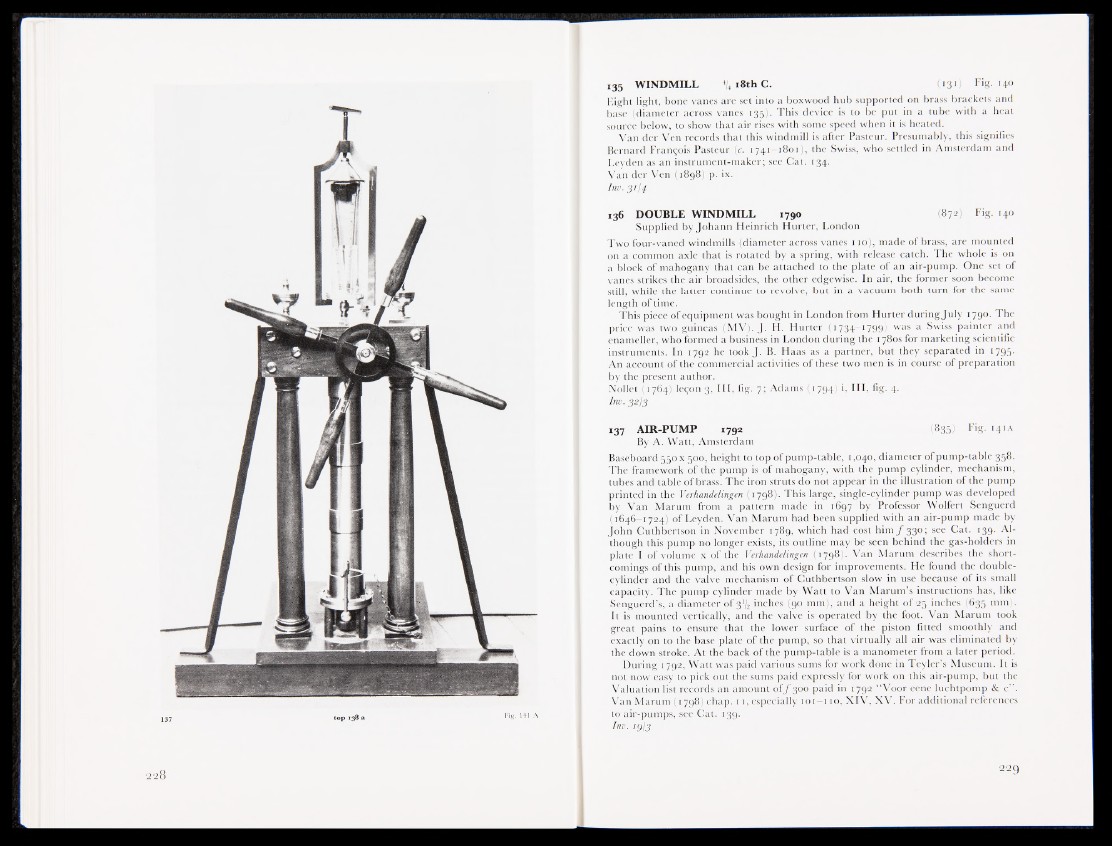
135 WINDMILL 4/4 18th C. (13O I’ig- 14°
Light light, bone vanes are set into a boxwood hub supported on brass brackets and
base (diameter across vanes 135)' This device is to be put in a tube with a heat
source below, to show that air rises with some speed when it is heated.
Van der Ven records that this windmill is after Pasteur. Presumably, this signifies
Bernard François Pasteur (c. 1741-1801), the Swiss, who settled in Amsterdam and
Leyden as an instrument-maker; see Cat. 134.
Van der Ven (1898) p. ix.
Inv. 3114
136 DOUBLE WINDMILL 1790 (872) Fig. 140
Supplied by Johann Heinrich Hurter, London
Two four-vaned windmills (diameter across vanes 110), made of brass, are mounted
on a common axle that is rotated by a spring, with release catch. The whole is on
a block of mahogany that can be attached to the plate of an air-pump. One set of
vanes strikes the air broadsides, the other edgewise. In air, the former soon become
still, while the latter continue to revolve, but in a vacuum both turn for the same
length of time.
This piece of equipment was bought in London from Hurter during July 17go. The
price was two guineas • MV). J. H. Hurter ( 1734-—1799) was a Swiss painter and
enameller, who formed a business in London during the 1780s for marketing scientific
instruments. In 1792 he took J. B. Haas as a partner, but they separated in 1795.
An account of the commercial activities of these two men is in course of preparation
by the present author.
Nollet (1764) leçon 3, III, fig- 7; Adams (1794) i, III, fig. 4.
Inv. 32I3
137 AIR-PUMP 1792 (835) Fig. 141A
By A. Watt, Amsterdam
Baseboard 550 x 500, height to top of pump-table, 1,040, diameter of pump-table 358.
The framework of the pump is of mahogany, with the pump cylinder, mechanism,
tubes and table of brass. The iron struts do not appear in the illustration of the pump
printed in the Verhandelingen (1798). This large, single-cylinder pump was developed
by Van Marum from a pattern made in 1697 by Professor Wolfert Senguerd
(1646-1724) of Leyden. Van Marum had been supplied with an air-pump made by
John Cuthbertson in November 1789, which had cost him ƒ 330; see Cat. 139. Although
this pump no longer exists, its outline may be seen behind the gas-holders in
plate I of volume x of the Verhandelingen (1798). Van Marum describes the shortcomings
of this pump, and his own design for improvements. He found the doublecylinder
and the valve mechanism of Cuthbertson slow in use because of its small
capacity. The pump cylinder made by Watt to Van Marum’s instructions has, like
Senguerd’s, a diameter of 3'/2 inches (90 mm),, and a height of 25 inches (635 mm).
It is mounted vertically, and the valve is operated by the foot. Van Marum took
great pains to ensure that the lower surface of the piston fitted smoothly and
exactly on to the base plate of the pump, so that virtually all air was eliminated by
the down stroke. At the back of the pump-table is a manometer from a later period.
During 1792, Watt was paid various sums for work done in Teyler’s Museum. It is
not now easy to pick out the sums paid expressly for work on this air-pump, but the
Valuation list records an amount ofƒ 300 paid in 1792 “Voor eene luchtpomp & c” .
Van Marum (1798) chap. 11, especially 101 110, XIV, XV. For additional references
to air-pumps, see Cat. 139.
Inv. 19/3